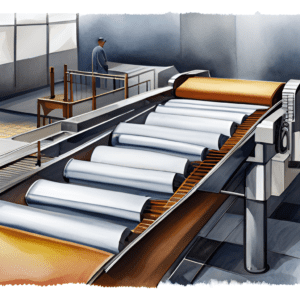

Paper plays a crucial role in our daily lives, from writing notes to reading books. But how often do we think about its journey?
It is the most versatile product one will ever come across. It is used for printing, packaging, labelling, crafts, etc. In this blog, we will take a journey through the process of making paper from the forest to your home.
We will explore the importance of paper-making and its impact on the environment. Join us, as we discover the fascinating world of paper production.
The Raw Material: Trees 
The primary raw material for making paper is Trees. Different type of trees are used, including softwood and hardwood trees. Softwood trees, such as pine and spruce, are commonly used to make paper pulp due to their long fibres. Hardwood trees, such as oak and maple, are used for making speciality papers.
Trees are a renewable resource, and responsible forestry practices ensure that new trees are planted to replace those that are harvested. This helps to maintain a healthy balance between the environment and paper production.
 Harvesting And Transporting Logs
Harvesting And Transporting Logs
Once the trees are harvested, they are transported to the paper mill. This is often done using trucks or trains, depending on the location of the forest and the mill. The logs are sorted according to the species and size to ensure consistent quality.
Transporting logs can be a challenging process, but it is essential to ensure a steady supply of raw materials for paper production. Proper handling and transportation help to minimize waste and ensure that the logs arrive at the mill in good condition.
 Pulping And Screening
Pulping And Screening
The logs are then processed through a series of machines to create pulp, the raw material of paper. This process is called pulping and involves separating the fibers from the rest of the wood. The pulp is then screened to remove any impurities and refined to improve its quality.
The type of pulp used depends on the type of paper being produced. Different pulping methods can be used to create different types of pulp, including mechanical and technical pulping. Each method has its advantages and disadvantages, depending on the desired end product.
Paper Making
Once the pulp is ready, it is fed into a paper machine. The machine forms the pulp into a continuous sheet of paper. The sheet of paper is then dried and rolled onto large spools. Depending on the type of paper being produced, additional steps may be required, such as coating or calendaring.
There are many different types of paper machines, each designed to produce a specific type of paper. These include Fourdrinier, cylinder, and twin-wire machines.Each machine has its own unique features and advantages, depending on the desired end product.
The Final Product 
The paper produced at the mill is used to create a wide range of paper products, from books and newspapers to packaging materials and tissues. Paper is an essential part of our daily lives, and we often take it for granted. But the process of papermaking is complex and fascinating.
Sustainable forestry practices and responsible manufacturing processes can ensure that paper product remains environment friendly and economically viable for generations to come.
Importance Of Paper
Paper is a blank canvas. What you put on it, stay on it.
Paper is something that we require in our daily life. Moreover, one cannot imagine life without it. Be in schools, office or shop, you need to have paper in one form or the other. In Schools, it is required in the form of books, in the shop for packaging purposes, and in the office to carry out the daily official work.
Paper makes our life easier. At work, office papers help us communicate. In daily life, paper bag works as our shopping bag, the cards, letters and packages we receive, the cup that holds our takeout coffee, and the album that holds our memories. In student’s life, notebooks, origami, labelling, bringing out their imagination to life through a sketch on a blank sheet, etc.
Paper products serve as valuable and proven learning tools, effective communication and connection points, permanent records for life’s milestones and secure forms of documentation. In a world full of technology, we still require a few documents in hard copy, such as marriage contracts, students’ diplomas or certificates.

 Harvesting And Transporting Logs
Harvesting And Transporting Logs Pulping And Screening
Pulping And Screening

